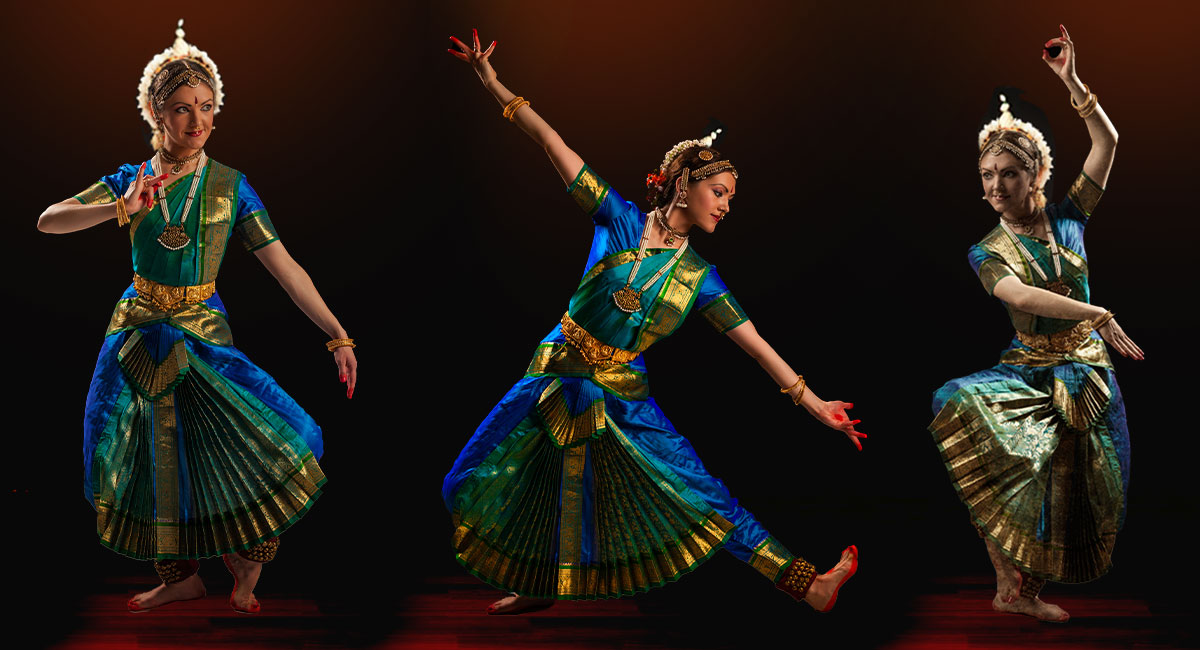Grace in Motion: The Postures, Mudras, and Expressions of Odissi
Odissi is one of India’s eight classical dance forms. It is a fascinating blend of grace, rhythm, and storytelling. Rooted in the temples of Odisha, this dance form embodies devotion and artistry through its unique postures, complex hand gestures (mudras), and expressive facial movements. Each movement in Odissi is a testament to its rich cultural heritage, blending sculpture-like stances with fluid storytelling to create a visual symphony. Let’s delve into the classical elements that make Odissi an enchanting dance form.
The Sculptural Beauty of Odissi: Postures That Define Grace
Odissi is renowned for its distinctive postures, inspired by the temple sculptures of Odisha. The elegance of the dance comes from the perfect balance between two fundamental stances:
- Chowka: The Square Stance
The chowka is a powerful and symmetrical stance representing Lord Jagannath, the presiding deity of Odisha. In this position, the dancer maintains a broad, grounded stance with knees bent and arms extended outward, forming a square-like shape. This posture embodies strength, masculinity, and stability; dancers often use it in vigorous movements.
- Tribhanga: The Three-Bend Posture
One of the most iconic postures of Odissi, the tribhanga (meaning “three bends”), represents femininity and fluidity. The body is elegantly curved at the head, torso, and knee, creating a mesmerizing S-shape. This posture captures the essence of grace and is widely used to depict divine figures like Lord Krishna and Radha.
The Language of Hands: Expressive Mudras in Odissi
Mudras, or hand gestures, are integral to Odissi, serving as a medium for storytelling. They help convey emotions, depict characters, and illustrate narratives from Hindu mythology. Odissi’s two main types of mudras are Asamyukta Hasta (single-hand gestures) and Samyukta Hasta (double-hand gestures). Here are some essential ones:
- Pataka (Flag)
A straight palm with fingers held together and the thumb slightly bent. Dancers use this mudra to depict clouds, wind, or blessings.
- Ardhachandra (Half-Moon)
The palm remains open, fingers extended, but the thumb stretches outward. It symbolizes the crescent moon, offering, or movement.
- Alapadma (Lotus Blooming)
Dancers gracefully spread their fingers out, resembling a blooming lotus. This mudra signifies beauty, divinity, and grace.
- Anjali (Salutation)
Dancers join both palms together to represent greeting, devotion, or offering prayers.
- Katakamukha (Bracelet Opening)
Fingers form circular shapes, often representing holding a garland or picking flowers.
In Odissi, every mudra adds complexity to the story by bringing mythological figures and goddesses to life on stage.
The Soul of Odissi: Expressions That Speak Volumes
Beyond postures and mudras, Odissi dancers celebrate abhinaya, bringing stories to life through expressive storytelling. Facial expressions, or bhavas, are crucial in conveying emotions and immersing the performance.
- Sringara (Love and Beauty)
Often depicted through graceful eye movements and soft smiles, sringara expresses love, devotion, and romance, particularly in Radha-Krishna narratives.
- Raudra (Anger and Fury)
Wide eyes, flared nostrils, and sharp gestures characterize raudra. This expression often portrays fierce gods like Durga or Shiva in their wrathful forms.
- Hasya (Joy and Laughter)
A radiant smile and lively expressions convey happiness, playfulness, and humor in dance sequences.
- Karuna (Compassion and Sorrow)
Drooping eyes, quivering lips, and slow, mournful movements evoke emotions of grief and compassion, allowing the audience to connect deeply with the story.
- Bhayanaka (Fear and Dread)
Trembling lips, shivering hands, and widened eyes create an atmosphere of fear, depicting scenes of danger or anxiety.
Expressions in Odissi are deeply nuanced, enabling the dancer to transition between various emotions and captivate the audience seamlessly.
Bringing It All Together
What sets Odissi apart is the synchronization of postures, mudras, and expressions into a seamless dance narrative. A well-trained Odissi dancer effortlessly merges strength (chowka) and grace (tribhanga), using symbolic hand gestures and emotive facial expressions to narrate mythological stories. A memorable performance is further enhanced by the music, which is full of rhythmic beats and traditional ragas.
A Dance That Echoes Through Time
Odissi is more than just a dance—it is a spiritual journey that connects the dancer and the audience with ancient traditions and divine storytelling. The sculptural postures, eloquent mudras, and soul-stirring expressions transcend time, creating a captivating art form. Whether you are a dancer, an admirer of Indian classical arts, or simply a lover of culture, Odissi offers a window into a world where movement becomes poetry and devotion takes center stage.
The next time you see an Odissi performance, take note of the expressive expressions, flowing postures, and delicate hand motions. Each tells a story that has been passed down through generations, keeping the spirit of this classical dance alive.


